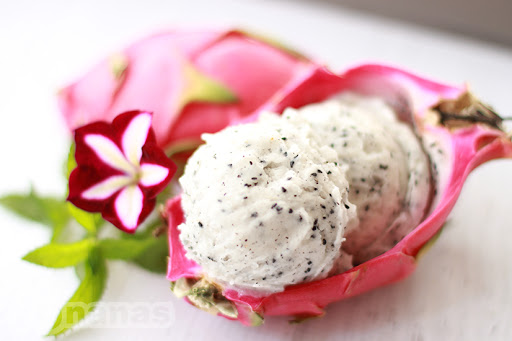Fascinating and Often Forgotten Fruit & Vegetables – How to Grow and Use Them

History
Dragon fruit or Pitaya refers to the fruit of the genus Hylocereus, of the family Cactaceae. According to Aztec literature, Pitaya fruits date back to the 13th century and were extensively grown in Central America. Dragon fruit is now cultivated in Southeast Asia, Florida in the United States, the Caribbean, Australia, and throughout tropical and subtropical regions of the world. Dragon fruit is among the most nutritious and wonderful exotic fruits. It is a favorite to many, particularly people of Asian origin.
More and more people are attempting to grow their own dragon fruit and it can now be found in most greengrocers and supermarkets.

Nutrition of Dragon Fruit
Pitahaya fruits are highly concentrated with Vitamin C, minerals, and boasts of high fiber content. The following table shows a characteristic nutritional value of the dragonfruit. Basically, these nutrients are vital and known world over for the antioxidants they possess which may help in the prevention of the formation of free radicals that have been linked to cancer
- Carotene helps maintain and equally improve the health of the eyes
- The fiber enhances digestion in our bodies
- The fiber equally reduces fat
- The protein component of the pitaya fruit enhances the body’s metabolism
- Calcium reinforces bones and aid in formation of healthy teeth
- Vitamin B2 acts as a multi vitamin to recover and improve loss appetite
- Vitamin B1 assists in production of energy as well as metabolizing carbohydrates
- Vitamin B3 lowers bad cholesterol level and enhances the appearance of the skin by moisturizing and smoothening it
- Vitamin C ensures bruises and cuts heal faster and improves the general immune system of our bodies
- Phosphorus aids in tissue formation.
| Fiber | 0.9g |
| Fat | 0.61g |
| Ashes | 0.68g |
| Carotene | 0.012g |
| Water | 83.0g |
| Phosphorus | 36.1mg |
| Ascorbic Acid | 9.0mg |
| Protein | 0.229g |
| Riboflavin | 0.045mg |
| Calcium | 8.8g |
| Niacin | 0.430mg |
| Iron | 0.65mg |
How to Grow Dragon Fruit

There are many varieties of dragon fruit but they are not a tree. Rather they are usually trellised to an old stump or post. All produce these stunning huge flowers but usually they flower at night and are often pollinated by large moths or small microbats rather than bees.
They can be grown from seed but are usually grown from cuttings off the mother plant. Growing them is relatiely easy both outdoors or in pots.
Dragon fruit is a cactus, which means it loves heat and sun. It’s better to plant it in a spot that is dry and sunny. If you live in a very hot climate, it’s best to choose a location that remains partially shaded. If you live in a cooler area or one that is subject to frost better to grow it in a pot or greenhouse. The plant is actually a climbing cactus and needs support to climb on, usually, as the plant becomes mature, it forms aerial roots from the branches and finds something to climb. So, it’s best if you’re growing dragonfruit, find something to support your plant. Attach a sturdy trellis or make an arbor. Many people use an old fence post to train up 2-3 at a time.
For growing dragonfruit, opt for well-draining soil that is sandy and loamy. A mixture of sand in garden soil would be appropriate. It is forgiving to poor soil. Since the dragon fruit is a cactus, water it moderately with care like you do with other succulents. Water only when the soil dries out.
Fertilize dragon fruit with a balanced fertilizer every month when the plant is actively growing in its growing season. Stop fertilizing in winter if you’re growing it in a cool climate. Side dressing with aged manure or compost can also be done occasionally.
Pruning is required to train this plant on the trellis, improve air circulation, and prevent fungal infection and maintain its height. Otherwise, it can grow up to 20 feet tall in the optimum growing conditions. Prune it annually by removing all the overgrowing, decaying, overcrowding, and dead stems saving only the healthier and productive ones. Check out this pruning guide to learn more!
There are particularly no pests that nag the plant seriously. Although keep an eye on aphids, they feed on young shoots and flower buds. Fungal diseases and root and fruit rot are possible if the plant is overwatered or exposed to too much rain. Many dragon fruit varieties are self-pollinating, but some require cross-pollination. If your dragon fruit is unable to self-pollinate, you’ll need to grow two or more dragon fruit plants carefully for cross-pollination.
In usual climates, dragon fruit bears fruit multiple times from summer to late fall and probably winter. It depends on the climate.
If you’re growing it in a temperate region, it’ll fruit between summer to early and mid-fall.
Your dragon fruit tree will start to produce flowers and fruits once it is established. This will happen in the first or second year after planting.
Harvest dragon fruit when its skin color changes from bright green to red or pink. Its fruit is oval to ovate in shape and 10 to 15 cm long and forms 30 to 50 days after flowering.
The pericarp of dragon fruit is rough and scaly and is usually pink in color. However, there are also red or yellow dragon fruits depending on the variety. The flesh is located in the interior is white and contains black seeds.
Get Your Taste Buds Ready






As you can see this unusual looking fruit is extremely versatile and I have to tell you extremely tasty. The only question is – will you grow something new! #getinmygarden



